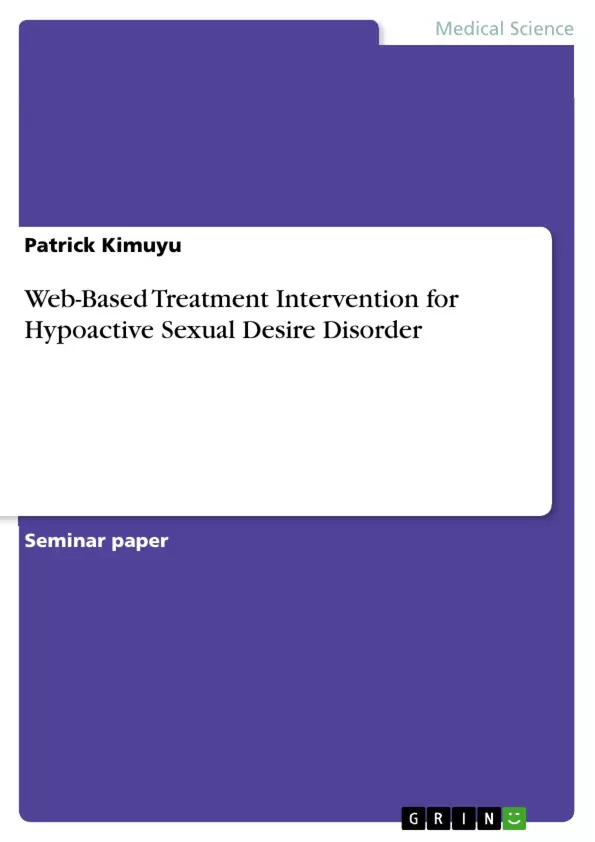This essay proposes hypoactive sexual desire disorder (HSDD) as the psychological issue that can be addressed through web-based interventions. In retrospect, technological advancement has been one of the factors underpinning the expansion of the medical field. Over the years, new technological inventions have led to the introduction of new medical perspectives ranging from diagnosis, treatment and prevention of different health conditions and disorders.
In the field of mental health, technological advancement seems to have augmented psychological treatment interventions, as well as the assessment of various aspects of different mental disorders. According to Ritterband et al., the evolution of web-based intervention platforms holds the potential for enhancing treatment for conditions in which patients show little interest seeking for treatment. In this context, it is worth noting that most interventions for mental disorders focus on behavioral modifications which, in turn plays an integral role in improving the underlying symptoms. On the other hand, health-related information websites have been found to be useful to patients. This has been evidenced by Pew Research Center (2002), in which surveys show that people’s knowledge on different health condition has been improved through internet education.
Inhaltsverzeichnis (Table of Contents)
- Technological Advancement and Mental Health
- Hypoactive Sexual Desire Disorder (HSDD): A Focus on Web-Based Intervention
- The Rationale for a Web-Based Intervention for HSDD
- Key Elements of the Proposed Web-Based Intervention
- Assessing the Effectiveness of WBI for HSDD
- Legal and Ethical Considerations for Web-Based Intervention
Zielsetzung und Themenschwerpunkte (Objectives and Key Themes)
This essay proposes a web-based intervention (WBI) for hypoactive sexual desire disorder (HSDD), focusing on the potential benefits and challenges of utilizing technology in addressing a significant yet often neglected mental health issue.
- The impact of technological advancement on mental health treatment.
- The prevalence and clinical significance of HSDD.
- The rationale for developing a WBI for HSDD.
- Key elements of an effective WBI for HSDD.
- Legal and ethical considerations related to WBI for HSDD.
Zusammenfassung der Kapitel (Chapter Summaries)
- This chapter explores the role of technology in advancing the medical field, particularly in mental health treatment, and introduces the concept of web-based intervention platforms as a potential solution for addressing the challenges associated with traditional treatment approaches for mental disorders.
- This chapter presents HSDD as a significant sexual dysfunction disorder that deserves more attention from healthcare professionals. It highlights the prevalence of HSDD, the barriers to seeking treatment, and the potential benefits of internet-based interventions in addressing these challenges.
- This chapter provides a detailed rationale for using a WBI to address HSDD, focusing on factors like the increasing availability of handheld devices, the potential for tailoring interventions to individual needs, and the opportunity to address compliance issues.
- This chapter outlines the key elements that should be incorporated into a comprehensive WBI for HSDD, including diagnostic tools, co-morbidity identification, and core treatment approaches like psychotherapy and pharmacotherapy.
- This chapter explores various methods for assessing the effectiveness of a WBI for HSDD, including prospective studies, tracking new case reports, and comparing compliance rates between WBI and traditional interventions.
Schlüsselwörter (Keywords)
This essay delves into the potential of web-based interventions (WBI) for addressing hypoactive sexual desire disorder (HSDD). Key terms include technological advancement, mental health treatment, sexual dysfunction, prevalence, barriers to treatment, diagnosis, co-morbidity, psychotherapy, pharmacotherapy, effectiveness assessment, legal and ethical considerations, privacy, and confidentiality. The discussion draws upon existing research and guidelines from organizations such as the American Psychiatric Association (APA).
- Citation du texte
- Patrick Kimuyu (Auteur), 2018, Web-Based Treatment Intervention for Hypoactive Sexual Desire Disorder, Munich, GRIN Verlag, https://www.grin.com/document/412254



